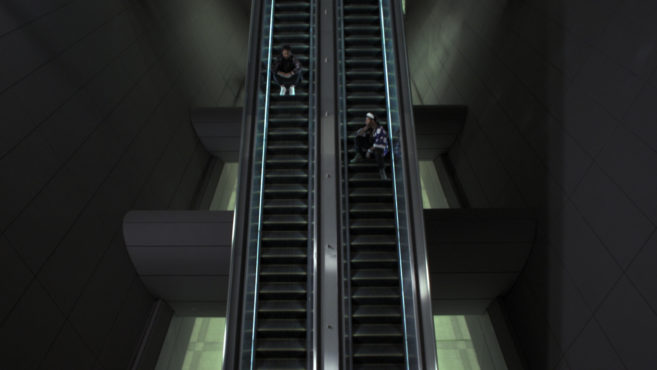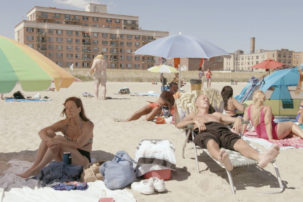The Greater World Earthship Community is located in Taos, New Mexico and sits on a large piece of flatland about two miles from the steep lip of the Rio Grande gorge. Earthships are sustainably built, half-underground, off-grid houses, a late-1980s apocalyptic-environmentalist vision by rogue architect Michael E. Reynolds. The Community is most beautiful at dusk, when solar-powered living-room lamps flicker on under emerging blankets of stars, with no power lines above to obstruct the view.
When the weather is good, as it tends to be in New Mexico, distinctions between outside and inside can feel blurred. In his 1990 manual on how to build an earthship, Reynolds likens the structure to a battery, which finds its precedent in a stone, capable of retaining heat for hours. Inside most earthships, gardens line the inside of windows, slanted toward the early-to-midday sun. Earthships are informed by the ancient, adobe style of building, which uses bricks made of dirt, straw and water, an Indigenous innovation dating back millennia. On the east side of the Rio Grande Gorge, the Taos Pueblo, in existence for over a thousand years and home to the Red Willow people, perseverant under the double-colonization of the Spanish and the Americans, attests to this. Here, mudfloors in adobe houses are throughways from exterior to interior, with doors left open during business hours for settler-colonial tourists to enter and purchase crafts. But a home is not a home without boundaries, fortification and even exclusivity. The largest area of Taos Pueblo is private. As I was told during a tour: the Tanoan or Tiwa language of the Red Willow people is oral and not for tourists to understand or consume; the sacred water of Red Willow Creek is used for cooking and washing by residents but could make me sick; nearby Blue Lake, taken from Pueblo residents in 1906 by Theodore Roosevelt’s administration, and regained in the 1970s through protest and lobbying, is now used exclusively by tribal members.
Home is the subject of this year’s iteration of SITElines, a biennial exhibition south of Taos in Santa Fe dedicated to “new perspectives on art from the Americas.” In 2018, curators José Luis Blondet, Candice Hopkins and Ruba Katrib have called it “Casa Tomada,” after a 1946 story by late Argentinian writer Julio Cortàzar. Despite its brevity and laconicism, the story is nowhere to be found in the SITE space, though an introductory didactic summarizes it more or less as follows: The narrator and his sister idle away in a large house in Buenos Aires, independently wealthy. One day, ghost-like intruders overtake half the house, and the narrator and his sister make do with inhabiting the other half, coexisting cautiously but calmly. Finally, the entire house is taken over, and the two go out into the street, locking the door and throwing the house key in a sewer, taking nothing else with them but a wristwatch.
Though the didactic describes Cortàzar’s story as “a complex tale of class and dispossession” about “who belongs—when, where, how and why,” it is also about humanity’s capacity to normalize anything. “We were fine,” the narrator of the story says after the intruders take over half the house. “Little by little we stopped thinking. You can live without thinking.” This last aspect is faint in SITElines, however, where the majority of artists appear to want to challenge the inherent dominance of colonial-capitalist spaces—to resist the status quo rather than to show how the status quo is made (i.e., by swallowing resistance). It seems noteworthy that one of the few artists in “Casa Tomada” preoccupied with the latter, Lutz Bacher, is well-known in the art world for using a pseudonym, hiding her identity as part of her work. Her projection of still images, Open the Kimono, shows oblique, ironic, handwritten notes attempting to process the quote-unquote shock of Trump’s 2016 win. Another of her works is a found whiteboard from a grade-school classroom onto which historical moments, radical or otherwise, have been markered to be made memorizable, and therefore banal.
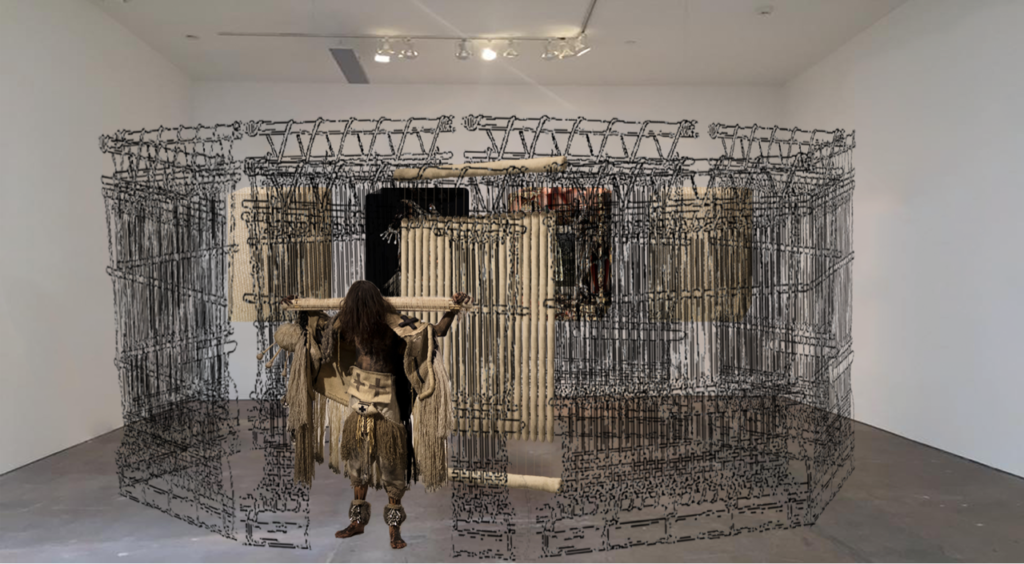
Eric-Paul Riege, diyin+, hooghan and weaving dance (fig.3) for Na'ashjé'íí Asdzáá, r.e.a., 2018. Mixed fibre, installation and performance, dimensions variable. Photo courtesy the artist.

Victoria Mamnguqsualuk, Flesh Eating Monster, 1984. Stonecut stencil, 63.5 x 85.1 cm.
In separate monographic essays, the three SITE curators describe their perspectives. Katrib, who appears to curate artists mostly from the US, is concerned with “notions of displacement and removal”; Hopkins, who brings forward a variety of Indigenous perspectives, is concerned with “other narratives, stories in which those described as lacking in power begin to turn the tables in order to restore the space of freedom…a space where words have both power and play”; Blondet, who appears to curate artists mostly from Central and South America, is concerned with “contest[ed] notions of belonging… [and] timely questions about what constitutes a shelter, a refuge, a hospice. And, more boldly, who and what is a foreigner.”
Not dissimilar from Documenta 14, for which Hopkins was also co-curator, SITElines creates gradations of tension by bringing forward groups of artists who choose not to be bound by art-world canons and orthodoxies, and by occasionally combining them with documentary-style work showing the socially subjugated or excluded. One room in the middle of the exhibition features an installation by young Diné artist Eric-Paul Riege, alluding to, in Hopkins’s words, “the ancient home of Na’ashje’íí Asdzáá (Spiderwoman)…a sacred space, one of sanctuary, and a beginning, a womb.” Around this installation are 1980s drawings and textiles by Victoria Mamnguqsualuk, an Inuk from near Garry Lake, Nunavut, who depicts the wandering, fantastical character Kiviuq. Each artist’s material-spiritual world seems capable of subsuming anything. (In Riege’s installation, a small, plush, manufactured lamb’s head is affixed to the back of a ceremonial hood.) Bracketing this middle room are suites of images by famed Chilean photographer Paz Errázuriz—one, a commission for SITE with Sergio Parra, showing sex workers from Talca, Chile in the 1960s and 1970s alongside ID cards used to track and control them, and another, Nomads of the Sea (1996), showing the Indigenous Kawésqar people from the Western Patagonia. Here, in counterpoint, is distance: a sense of an “us” and a “them,” of voyeurism, of the porthole-like quality of photographs. (On Errázuriz’s Wikipedia page, she is quoted talking about the subjects of her photographs in a manner we might associate with Diane Arbus: “They are topics that society doesn’t look at, and my intention is to encourage people to dare to look.”)
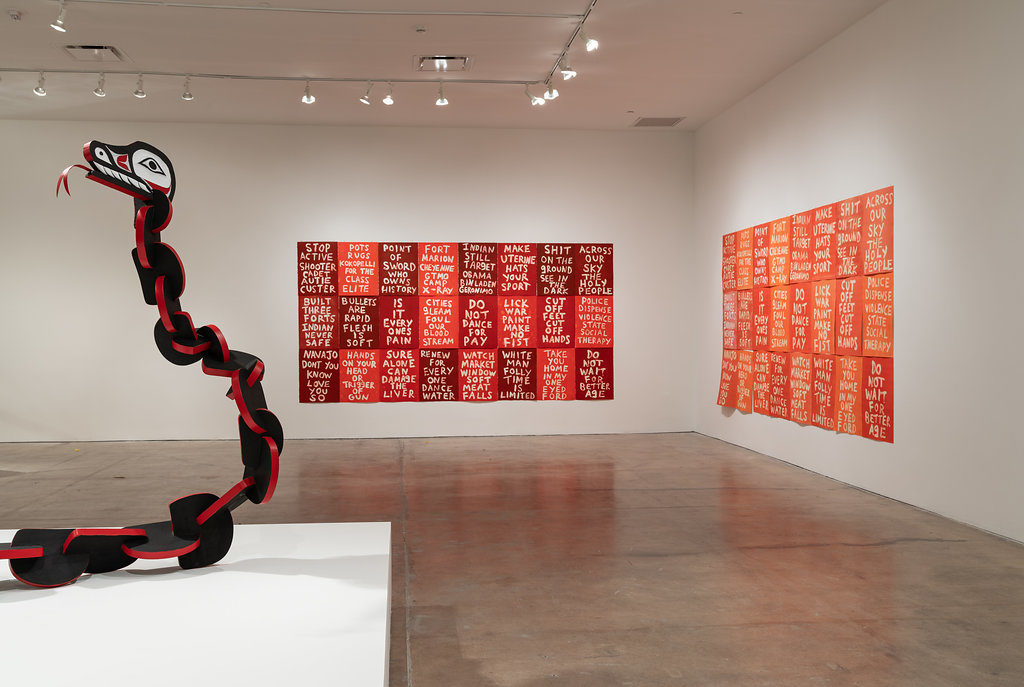 Foreground: Lawrence Paul Yuxweluptun,
Neo Totems, 2018. Acrylic paint and cedar,
five sculptures, varying dimensions. Courtesy the artist and Macaulay & Co. Fine Art. Background: Hock E Aye Vi Edgar Heap of Birds, Surviving Active Shooter Custer, 2018. Monoprints and ghost prints on buff-rag paper, 48 prints each 76.2 cm x 55.8 cm.
Courtesy the artist.
Foreground: Lawrence Paul Yuxweluptun,
Neo Totems, 2018. Acrylic paint and cedar,
five sculptures, varying dimensions. Courtesy the artist and Macaulay & Co. Fine Art. Background: Hock E Aye Vi Edgar Heap of Birds, Surviving Active Shooter Custer, 2018. Monoprints and ghost prints on buff-rag paper, 48 prints each 76.2 cm x 55.8 cm.
Courtesy the artist.
The biennial’s last room collects work by Hock E Aye Vi Edgar Heap of Birds, Curtis Talwst Santiago, Lawrence Paul Yuxweluptun (Santiago’s mentor) and Victor Estrada, artists who, in varying ways, use vernaculars of the artworld—pastiche-readymade, Pop art, formalist sculpture, big painting, text—to articulate identities and narratives the artworld has marginalized. These artists are not discoveries of the biennial; they are successful already and know how to speak within white cubes. The room looks good in the familiar manner of institutional installation. It is a curiously stabilizing ending for a biennial generally purporting, in its focus on “the Americas,” and in calling itself “SITElines,” to be mindful of the charged particularities of place. Then there’s the matter of the Cortàzar thematic: if the art institution is another kind of home, shouldn’t viewers leave with the feeling that it has somehow been haunted?
At the risk of asking too much of a biennial, or providing a solution-based ending to this review, it feels necessary to answer this by rewinding to “Casa Tomada”’s beginning: a work, facilitated by the curators themselves, that is a replica-in-clay of a bronze foot, one that, on the night of December 29, 1997, was cut off a statue of the first governor of New Mexico, Don Juan de Oñate, in Alcalde, a community north of Santa Fe. Along with the clay replica of the foot, the curators have provided a variety of contemporaneous documents and articles, parsed with didactics. We are told of a letter sent to press by “Friends of Acoma People,” along with photocopies from a historical book, reminding the public that Acoma Pueblo, southwest of Alcade, had been captured by the particularly violent Oñate in the sixteenth century (the anniversary of this “founding” was approaching, in 1999), and involved taking hundreds of Indigenous people prisoner, and decapitating their feet. We are told of the “Friends of Acoma People”’s further suggestion that the bronze foot be melted down and “cast into medallions to be sold to those who are historically ignorant.” The curators note that “only the top portion of the foot’s ankle was melted down to make medallions”: one of the medallions is presented in a vitrine. Another didactic explains that the curators “were allowed access to the original foot,” and thanks “all of the individuals who helped make this presentation of the cast replica possible, as well as those who advised and discussed this project with us, their input and assistance has been invaluable. The original foot remains secure in an undisclosed location.”
I am struck by the curators’ covert discussions with the people who committed this action; by the mutual gaining and maintaining of trust; by the knowledge I have been given by this display; by what I am forced to surmise about the inner workings (for lack of a better phrase) that made it possible; by what keeps me at a distance (from those who have committed this action and from those for whom this action was committed); by the confluence of methodologies between this action and conceptual art; by the tangles and elisions of this confluence; by the use of micaceous clay for the cast replica, of which renowned Acoma pottery is also constructed. I wonder whether this clever, moving work—the cast, the decapitation, the documentation, all of it—wouldn’t have been enough to give the exhibition its intended haunting, whether the Cortàzar reference was necessary at all.
I am equally struck by my last memory of New Mexico, a visit to the Georgia O’Keeffe house, twenty-three miles northwest of Alcade in Abiquiú, and accessible only by appointment. (You meet at the welcome centre and a van drives you up.) The allure of O’Keeffe’s memorialized existence in Abiquiú feels positively pornographic: the sweeping views, the adapted adobe, the greige-minimalist everything, the oxblood floors, the white-washed ceilings, the Japanalia, the rock collection, the garden, every pleasure ostensibly highlighting the defiantly isolationist self-reliance of a non-conforming, privileged white woman, alongside the blatant but unarticulated colonial aspect of it all. You salivate and feel weird about it later. The house was not O’Keeffe’s forever, however; she spent her last years in Santa Fe, closer to medical care. I am reminded of O’Keeffe’s paintings of her own patio, in which the structures of her house dissolve into the abstract infinite, the subject of all her work. There are homes for which we yearn, and there are homes to which we are inextricably drawn. Sometimes these are the same. In both, we are not alone.

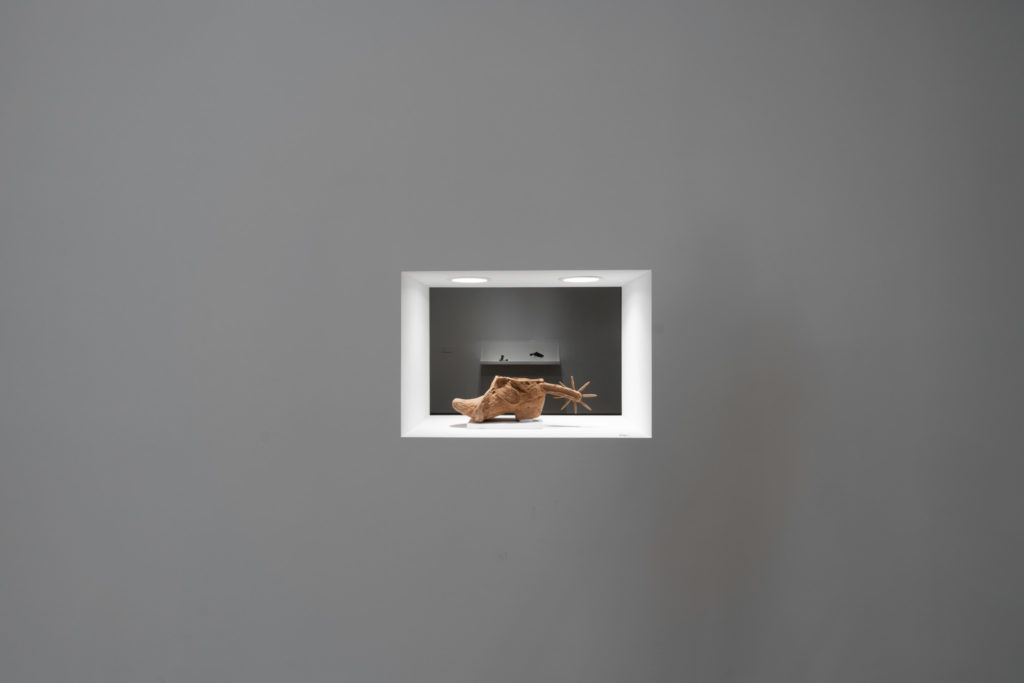 Installation view of a replica of a foot, taken from the statue of Don Juan de Oñate in Alcade, New Mexico.
Press mold in micaceous clay.
Photo: Eric Swanson.
Installation view of a replica of a foot, taken from the statue of Don Juan de Oñate in Alcade, New Mexico.
Press mold in micaceous clay.
Photo: Eric Swanson.
